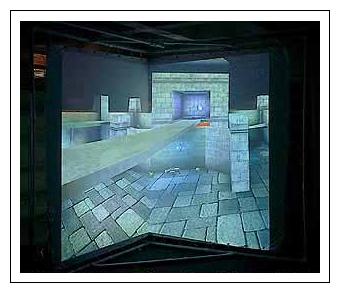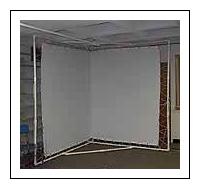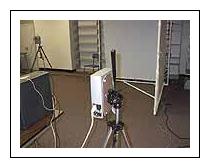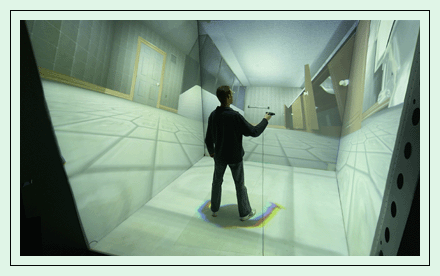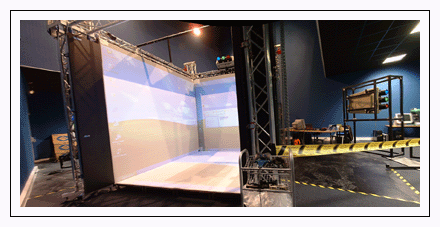Examples of CaveUT Implementations
BNAVE
|
CaveUT was originally developed on the BNAVE, a PC-based CAVE-like display the Medical Virtual Reality Center, Department of Otolaryngology, University of Pittsburgh.
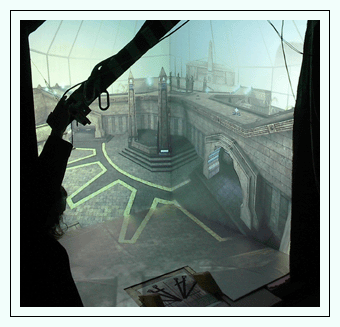
To the right is a picture of the BNAVE showing DM-Suntemple, a virtual world that comes prepackaged with UT. The screens are at an 80.5-degree angle to each other, and we are looking straight into the corner. (The image looks bent because the camera taking this picture could not be placed in the ideal viewing location; the image does not appear bent to someone standing in the correct position before the screens.)
The BNAVE consists of three walls arraigned in a "U" around the viewer. A fourth projection surface has been added to the floor.
Each wall is a rear-projection screen. Onto each of the three screens is rear-projected projected the SVGA output of a dedicated PC.
|
Mini Cave at VISIC Lab
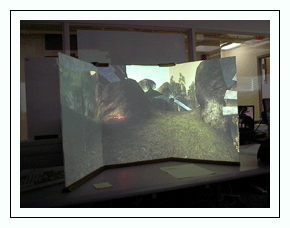 |
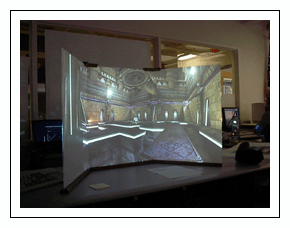 |
| DM-Antauls |
DM-Serpentine |
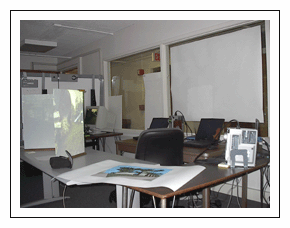 |
| Physical Setup |
These three images show CaveUT in the
"Mini Cave" at the VISIC Lab at the University of Pittsburgh. The mini-cave is a three-screen affair
small enough that all the computers required to run will it fit on a desktop. Its basic design is much like the BNAVE or any other generic PC-based cave.
The first image shows a virtual world called
DM-Antauls.
The second shows a virtual world called DM-Serpentine.
The last shows the physical setup of the computers running the mini-cave.
The VISC Lab also built a complete V-Cave (see below) for more immersive applications.
The Portable V-Cave
Earth Theater
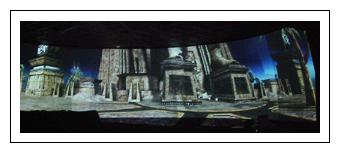
The Earth Theater (left) at the Carnegie Museum of Natural History has a CaveUT installation. The theater has a fully digital display composed of five curved front-projected screens spanning 210 degrees horizontal and 30 degrees vertical. Five standard video projectors, each driven by a PC running windows, produce the Unreal
Tournament display. As you would expect, each of the five projector PCs is running a spectator, which provides the appropriate view from a single player on a sixth PC.
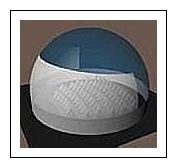
Interestingly, the careful design of the theater makes off-axis projection unnecessary. However, the curved screens require a spherical correction of the image, otherwise we get those wedge-shaped overlaps you can see in the image if you look closely. Willem de Jonge are just now working on a spherical correction to the OpenGL code.
On the right is a Schematic of the Earth Theater. The screen is a section of a sphere, 210 degrees horizontal by 30 deg vertical. In the figure, the screen is depicted in a transparent white in front of the seats.
CLARTE
Last updated January 16, 2004.
URL: http://www.planetjeff.net/ut/CaveUT.html
This page is copyright © 2004 by Jeffrey Jacobson.
See this web site's copyright notice for information
on duplicating or distributing this page or its contents.
|
|




